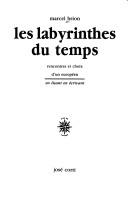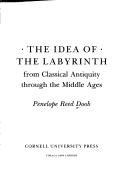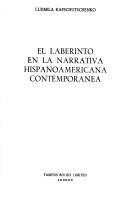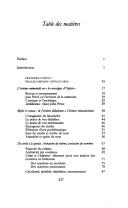| Listing 1 - 8 of 8 |
Sort by
|
Book
ISBN: 3892069980 Year: 2000 Publisher: Essen : Blaue Eule,
Abstract | Keywords | Export | Availability | Bookmark
 Loading...
Loading...Choose an application
- Reference Manager
- EndNote
- RefWorks (Direct export to RefWorks)
82:1 --- Literatuur en filosofie --- Labyrinths in literature. --- Labyrinths. --- Literature, Modern --- History and criticism. --- 82:1 Literatuur en filosofie --- Labyrinths --- Labyrinths in literature --- Mazes --- History and criticism
Book
ISBN: 9788882655952 Year: 2011 Publisher: Roma L'Erma di Bretschneider
Abstract | Keywords | Export | Availability | Bookmark
 Loading...
Loading...Choose an application
- Reference Manager
- EndNote
- RefWorks (Direct export to RefWorks)
Comparative linguistics --- Greek language --- Labyrinths in literature --- Nymphs (Greek deities) in literature --- Semantics

ISBN: 2714305156 Year: 1994 Publisher: Corti
Abstract | Keywords | Export | Availability | Bookmark
 Loading...
Loading...Choose an application
- Reference Manager
- EndNote
- RefWorks (Direct export to RefWorks)
Aging in art --- Labyrinths in literature --- Literature, Modern --- Space and time in art --- History and criticism

ISBN: 0801423937 1501738461 0801480000 1501738453 Year: 1990 Publisher: Ithaca : Cornell University Press,
Abstract | Keywords | Export | Availability | Bookmark
 Loading...
Loading...Choose an application
- Reference Manager
- EndNote
- RefWorks (Direct export to RefWorks)
Ancient and medieval labyrinths embody paradox, according to Penelope Reed Doob. Their structure allows a double perspective-the baffling, fragmented prospect confronting the maze-treader within, and the comprehensive vision available to those without. Mazes simultaneously assert order and chaos, artistry and confusion, articulated clarity and bewildering complexity, perfected pattern and hesitant process. In this handsomely illustrated book, Doob reconstructs from a variety of literary and visual sources the idea of the labyrinth from the classical period through the Middle Ages.Doob first examines several complementary traditions of the maze topos, showing how ancient historical and geographical writings generate metaphors in which the labyrinth signifies admirable complexity, while poetic texts tend to suggest that the labyrinth is a sign of moral duplicity. She then describes two common models of the labyrinth and explores their formal implications: the unicursal model, with no false turnings, found almost universally in the visual arts; and the multicursal model, with blind alleys and dead ends, characteristic of literary texts. This paradigmatic clash between the labyrinths of art and of literature becomes a key to the metaphorical potential of the maze, as Doob's examination of a vast array of materials from the classical period through the Middle Ages suggests. She concludes with linked readings of four "labyrinths of words": Virgil's Aeneid, Boethius' Consolation of Philosophy, Dante's Divine Comedy, and Chaucer's House of Fame, each of which plays with and transforms received ideas of the labyrinth as well as reflecting and responding to aspects of the texts that influenced it.Doob not only provides fresh theoretical and historical perspectives on the labyrinth tradition, but also portrays a complex medieval aesthetic that helps us to approach structurally elaborate early works. Readers in such fields as Classical literature, Medieval Studies, Renaissance Studies, comparative literature, literary theory, art history, and intellectual history will welcome this wide-ranging and illuminating book.
Doolhoven in de literatuur --- Labyrinten in de literatuur --- Labyrinthes dans la littérature --- Labyrinths in literature --- Classical literature --- -Labyrinths in art --- Literature, Medieval --- -European literature --- Medieval literature --- Literature, Classical --- Literature --- Literature, Ancient --- Greek literature --- Latin literature --- History and criticism --- Labyrinths in art. --- Labyrinths in literature. --- History and criticism. --- -History and criticism --- Labyrinths in art --- Literature [Medieval ]

ISBN: 0729301184 9780729301183 Year: 1981 Volume: 85 Publisher: London : Tamesis,
Abstract | Keywords | Export | Availability | Bookmark
 Loading...
Loading...Choose an application
- Reference Manager
- EndNote
- RefWorks (Direct export to RefWorks)
Spanish American fiction --- Labyrinths in literature --- History and criticism --- -Spanish American literature --- -History and criticism --- Spanish-American literature --- Thematology --- anno 1900-1999 --- Spanish American fiction - 20th century - History and criticism --- Roman hispano-americain

ISBN: 0820424269 Year: 1995 Volume: 10 Publisher: New York [etc.] Peter Lang
Abstract | Keywords | Export | Availability | Bookmark
 Loading...
Loading...Choose an application
- Reference Manager
- EndNote
- RefWorks (Direct export to RefWorks)
830 "19" KAFKA, FRANZ --- 830 "19" HESSE, HERMANN --- 830 "19" MANN, THOMAS --- German fiction --- -Labyrinths in literature --- German literature --- Duitse literatuur--20e eeuw. Periode 1900-1999--KAFKA, FRANZ --- Duitse literatuur--20e eeuw. Periode 1900-1999--HESSE, HERMANN --- Duitse literatuur--20e eeuw. Periode 1900-1999--MANN, THOMAS --- History and criticism --- 830 "19" MANN, THOMAS Duitse literatuur--20e eeuw. Periode 1900-1999--MANN, THOMAS --- 830 "19" HESSE, HERMANN Duitse literatuur--20e eeuw. Periode 1900-1999--HESSE, HERMANN --- 830 "19" KAFKA, FRANZ Duitse literatuur--20e eeuw. Periode 1900-1999--KAFKA, FRANZ --- Labyrinths in literature
Book
ISBN: 9781644533109 1644533103 Year: 2024 Publisher: Newark, DE : University of Delaware Press,
Abstract | Keywords | Export | Availability | Bookmark
 Loading...
Loading...Choose an application
- Reference Manager
- EndNote
- RefWorks (Direct export to RefWorks)
The Visionary Queen affirms Marguerite de Navarre’s status not only as a political figure, author, or proponent of nonschismatic reform but also as a visionary. In her life and writings, the queen of Navarre dissected the injustices that her society and its institutions perpetuated against women. We also see evidence that she used her literary texts, especially the Heptaméron, as an exploratory space in which to generate a creative vision for institutional reform. The Heptaméron’s approach to reform emerges from statistical analysis of the text’s seventy-two tales, which reveals new insights into trends within the work, including the different categories of wrongdoing by male, institutional representatives from the Church and aristocracy, as well as the varying responses to injustice that characters in the tales employ as they pursue reform. Throughout its chapters, The Visionary Queen foregrounds the trope of the labyrinth, a potent symbol in early modern Europe that encapsulated both the fallen world and redemption, two themes that underlie Marguerite's project of reform.
Labyrinths in literature. --- Justice in literature. --- Reformation in literature. --- Short stories, French --- French literature --- Reformation --- History and criticism. --- Marguerite, --- Criticism and interpretation. --- Marguerite de Navarre, the Heptaméron, literary studies, religious studies, women's studies, gender studies, Renaissance studies, Renaissance France, the French Renaissance, early modern studies, early modern France, early modern literature, Reformation, French history, French literature, the trope of the labyrinth, the labyrinth.

ISBN: 2130498868 9782130498865 Year: 1999 Volume: *1 Publisher: Paris Presses Universitaires de France
Abstract | Keywords | Export | Availability | Bookmark
 Loading...
Loading...Choose an application
- Reference Manager
- EndNote
- RefWorks (Direct export to RefWorks)
Comparative literature
---
Thematology
---
Literature and myth
---
Literatuur en mythe
---
Littérature et mythe
---
Mythologie dans la littérature
---
Mythologie in de literatuur
---
Mythology in literature
---
Literature, Modern
---
Myth in literature.
---
Literature and myth.
---
Labyrinths in literature.
---
Littérature
---
Mythe dans la littérature
---
Labyrinthes dans la littérature
---
History and criticism.
---
Histoire et critique
---
-Myth in literature
---
#BIBC:ruil
| Listing 1 - 8 of 8 |
Sort by
|

 Search
Search Feedback
Feedback About
About Help
Help News
News